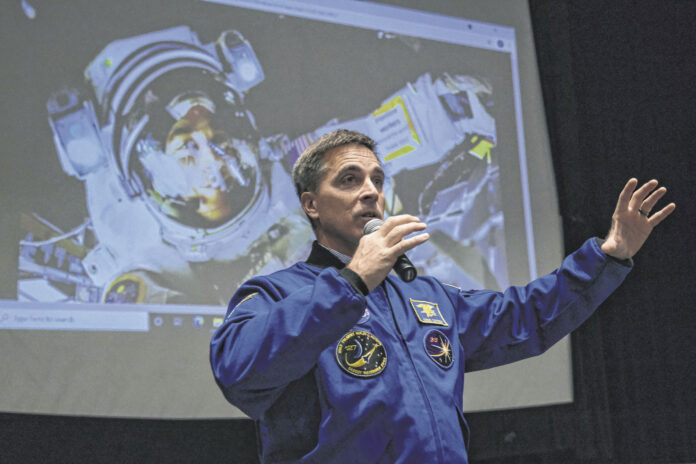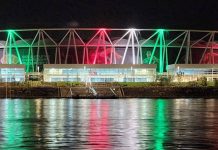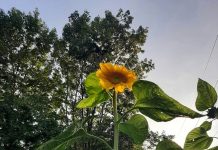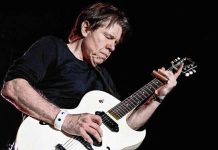
Retired NASA astronaut Chris Cassidy fielded several different questions Saturday at a meet and greet with local residents, ranging from asking about different types of space vehicles to what it was like to fall asleep in space.
And one child asked perhaps the most important question of all: Is it cool to be an astronaut?
“It sure is,” Cassidy responded. “And it’s cool for lots of reasons. And one of those is the experience of spaceflight. But the other thing that I find really cool is to share the stories with communities and schools and people just like you. And I feel really lucky that I’ve gotten to see the earth from that viewpoint and to help give everybody that view is something that I don’t take lightly.”
The former astronaut gave a presentation on his experiences — both in orbit with NASA and on the ground and underwater as a Navy SEAL — at Columbus North High School on Saturday. Afterward, he took part in a meet and greet at GreenTree at Westwood, a senior living facility.
And, of course, he confirmed that being an astronaut is as cool as everyone suspected.
However, in an age where visitors to space now include Jeff Bezos, Richard Branson and William Shatner, the definition of astronaut is perhaps beginning to shift.
When one audience member asked Cassidy how he feels about the short-duration spaceflights of Branson and Bezos, he replied, “I’m all for it. In my mind, if you strap yourself to a pile of fuel and somebody lights it, you can call yourself whatever the heck you want.”
For his part, Cassidy said he didn’t know as a kid that he would become an astronaut. In fact, when he landed on his final mission, there was a part of him that wondered, “How did I get here? How in the world am I in this position right now?”
He first realized he wanted to become an astronaut after meeting another Navy SEAL, Bill Shepherd, who had become an astronaut. Before that time, Cassidy didn’t realize he could apply to become one; he saw it as “something that other people do.” When he met Shepherd, he realized that they had similar backgrounds, which meant Cassidy might also be a “competitive applicant.”
However, Cassidy would never have become a Navy SEAL if it hadn’t been for another man.
As a senior in high school, Cassidy became interested in attending the U.S. Naval Academy in Annapolis. However, there was a snafu, and when he called the admissions office to check about the status of his application, he was told that he wasn’t in their system.
Cassidy later visited the academy, where he spoke to U.S. Marine Corps. Captain Michael Melillo about his situation.
“I could tell he was trying to size me up,” Cassidy said. “Like, ‘Is this guy a total idiot? Everybody else got their application in. Why didn’t this guy?’ But he was honestly listening.”
Melillo said he’d get back to Cassidy. Just a week later, he called to say that he could get Cassidy into the academy if he first attended the Naval Academy Prep School. Cassidy eagerly agreed.
“This guy, Captain Melillo, changed my life,” he said.
This isn’t the first time Cassidy’s told this story. He also recounted it at a departure party before his final mission, telling everyone how they wouldn’t be there if not for Melillo. And then, to his surprise, Cassidy’s wife, Peggy, told Melillo to stand up, and Cassidy was able to thank him.
“It was a crucial moment in my life, both then and later as an adult, realizing that each and everyone of us can be the Captain Melillo for somebody else,” Cassidy said. “We just don’t know when those opportunities will come about. And we interact with people every single day, both adults and children. We all do. And you never know when you’re going to have the impact like that that could change the trajectory of someone’s life.”
Without Melillo’s help, he said he would have never gone on to become a Navy SEAL and later an astronaut.
In discussing the latter, Cassidy said his favorite part of the job was the spacewalks.
“It’s the thing that makes you feel most like an astronaut,” he said. “… We have boring meetings and endless emails just like everybody else in the world.”
But on a “few special days” — 10 to be exact — Cassidy was able to experience something he described as both terrifying and extraordinary.
When the airlock hatch opens below an astronaut for the first time, looking down at the Earth “takes your breath away,” he said. And in his case, it also left him feeling frozen as he saw a straw (which had floated into the airlock) fly past him and disappear into space.
Spacewalking inspires a lot of different emotions, Cassidy said. There is a sense of urgency to stay focused on the job you’ve been sent to do. There’s also a feeling of pressure that comes from knowing how hard people have worked to create the equipment you’re using and a desire not to mess anything up. On top of that, Cassidy had a microphone on that was live to the internet, so he had to remember to be careful with what he said.
While spacewalks were his favorite part of being an astronaut, they were also the most challenging part.
“That’s why I think I like it so much,” he told The Republic. “Because it’s a challenge, but it’s super, super rewarding. You have this sense of accomplishment — not just as an individual but as part of a team, because there’s a large group of people on the ground who prepared the materials, who built the equipment, who made the procedure to get it to the point where there you are, at the moment of the spacewalk.”
Cassidy said that he was saddened to give this experience up when he left NASA.
His final mission was in October 2020 after Expedition 63.
Cassidy retired from the agency’s astronaut corps in May of 2021 after 17 years of service. He accumulated 378 days in space over the course of his career and completed three spaceflights: STS‐127 aboard space shuttle Endeavour and space station Expeditions 35 and 63.
His roles at NASA have included capsule communicator, support astronaut on the Space Shuttle Closeout Crew, Extravehicular Activity branch chief and Chief Astronaut.
“I’d been an astronaut for 17 years and flew in space three times,” he said. “It’s about normal to fly in space every six or seven years. And I was 51 and thinking ‘Do I want to wait around another six or seven years, might be 58 or something, for the chance of one more flight?’ … It was just a tough decision. Do I want one more six-month mission on the space station, or try to go experience something else?”
While Cassidy was contemplating that choice, he was contacted by the National Medal of Honor Museum.
In August, the museum’s foundation announced that Cassidy would serve as its new president and CEO. As such, he will lead the foundation’s project to build the National Medal of Honor Museum and Medal of Honor Leadership Institute in Arlington, Texas, as well as the National Medal of Honor Monument in Washington, D.C.
“That was a perfect fit, because I could then continue to serve the nation, just in a different way,” Cassidy said.
And he’s also happy to be able to continue to share his stories from NASA with other people.
As Cassidy signed the books of two young boys after his presentation, he said, “We’ve got room at NASA for both of you guys.”




